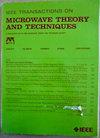A 28/39 GHz Concurrent/Band-Switching LNA With Three-Winding Transformer and Common-Gate-Based Multiplexer Supporting Multistream and Multiband 5G FR2 Communication
IF 4.1
1区 工程技术
Q2 ENGINEERING, ELECTRICAL & ELECTRONIC
IEEE Transactions on Microwave Theory and Techniques
Pub Date : 2025-02-04
DOI:10.1109/TMTT.2025.3529990
引用次数: 0
Abstract
In this article, a 28/39 GHz band reconfigurable low noise amplifier (LNA) is designed with concurrent and band-switching operation modes, aiming to flexibly support multiband and multistream 5G FR2 communication. For facilitating integration with a multiband antenna, the LNA first-stage leverages an ultra-compact three-winding transformer (TF) coupling technique, enabling relatively high power gain and low noise figure (NF) across both 28 and 39 GHz bands. Moreover, we adopt a一种支持多流和多频段5G FR2通信的28/ 39ghz并发/带交换LNA,具有三绕组变压器和基于共门的多路复用器
本文设计了一种28/ 39ghz频段可重构低噪声放大器(LNA),采用并行和带交换工作模式,灵活支持5G多频段、多流FR2通信。为了便于与多频段天线集成,LNA第一级利用超紧凑三绕组变压器(TF)耦合技术,在28 GHz和39 GHz频段上实现相对较高的功率增益和较低的噪声系数(NF)。此外,我们采用$\pi $ -模型,将复杂的优化问题分解为无源网络匹配和有源单元改进,带来更直观、严谨的设计见解和指导。在接下来的阶段,使用两个可切换的并行$g_{m}$ -boost共门(CG)放大器实现了一个带复用器,它将宽带信号分离为分频信号路径,从而支持并发和带切换模式。此外,分离路径的LNA输出级可以独立优化,以满足每个子带的特定要求。LNA采用65纳米CMOS工艺制造,核心面积紧凑,仅为0.1 mm2。在带交换模式下,峰值增益为26.3/25.5 dB, 3db带宽为21.8-30.3 GHz/ 32.6-45.1 GHz,最小NF为3.6/3.8 dB,三阶截获点(IIP3)为−18.5/−16.4 dBm, 28/39 GHz频段带外抑制分别大于10.3/15.7 dB,功耗为19.2 mW,电源为1.2 V。在并发模式下,LNA的峰值增益为22.9/23 dB,最小NF值为4.97/4.9 dB, IIP3值为−14.7/−12.4 dBm, 28/39 GHz频段的带外抑制大于10/11 dB,功耗为38.4 mW。
本文章由计算机程序翻译,如有差异,请以英文原文为准。
求助全文
约1分钟内获得全文
求助全文
来源期刊

IEEE Transactions on Microwave Theory and Techniques
工程技术-工程:电子与电气
CiteScore
8.60
自引率
18.60%
发文量
486
审稿时长
6 months
期刊介绍:
The IEEE Transactions on Microwave Theory and Techniques focuses on that part of engineering and theory associated with microwave/millimeter-wave components, devices, circuits, and systems involving the generation, modulation, demodulation, control, transmission, and detection of microwave signals. This includes scientific, technical, and industrial, activities. Microwave theory and techniques relates to electromagnetic waves usually in the frequency region between a few MHz and a THz; other spectral regions and wave types are included within the scope of the Society whenever basic microwave theory and techniques can yield useful results. Generally, this occurs in the theory of wave propagation in structures with dimensions comparable to a wavelength, and in the related techniques for analysis and design.
 求助内容:
求助内容: 应助结果提醒方式:
应助结果提醒方式:


